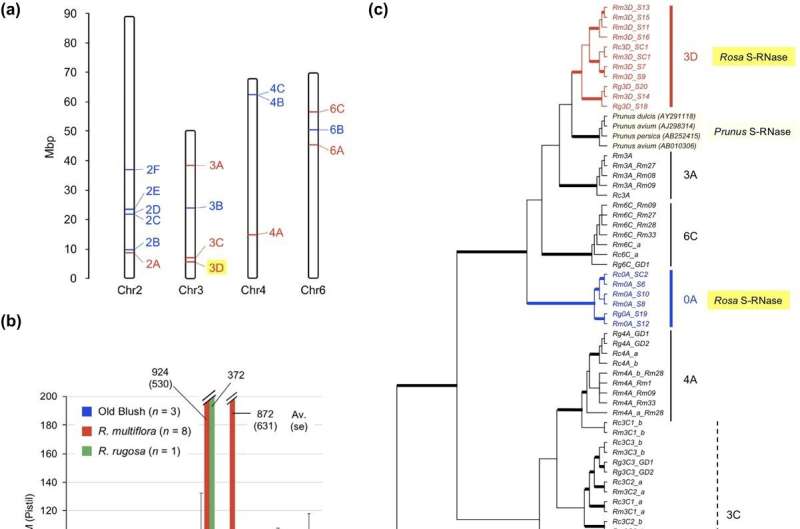This article has been reviewed according to Science X's editorial process and policies. Editors have highlighted the following attributes while ensuring the content's credibility:
fact-checked
peer-reviewed publication
trusted source
proofread
Revolutionizing rose breeding: Unraveling the mystery of self-incompatibility and genetic linkages in roses

Roses, celebrated worldwide for their ornamental value, have a long history of breeding and cultivation, with more than 30,000 cultivars. Roses are predominantly outcrossing and highly heterozygous plants, and patterns of inheritance for most traits are difficult to predict. As a result, rose cross breeding is extremely challenging.
Recent advances in rose genetics, including the development of molecular markers to construct genetic linkage maps and genome sequencing, have uncovered key genetic factors for traits such as scent, continuous-flowering (CF), and double-flower (DF). However, the S-locus controlling rose self-compatibility (SI) has not been fully elucidated, which is essential for improved breeding at the diploid level.
Related research has identified potential S-locus regions and associated S-RNase enzymes in the genome, but inconsistencies and limited pollination experiments leave the exact location and function of the S-locus unconfirmed.
In October 2022, Horticulture Research published a perspective titled "The identification of the Rosa S-locus provides new insights into the breeding and wild origins of continuous-flowering roses."
This study aims to identify the Rosa S-locus controlling self-incompatibility (SI), explore the genetic linkages of the S-locus with other ornamental traits, investigate the historical frequency changes of specific S-alleles (SC) in rose cultivars, and identify wild species carrying the Sc-alleles to infer wild origins of old Chinese CF cultivars. This research will potentially unravel key genetic connections and aid in more precise and efficient rose breeding practices.
Firstly, researchers conducted a genome-wide search for candidate S-RNase genes in the genome databases of Old Blush, R. multiflora, and R. rugosa. They identified 16 candidate genes located on four chromosomes, with seven expressed in the pistil.
Molecular phylogenetic tree analysis further identified the 3D and 0A genes as the primary candidates for S-RNase. And nine additional 3D S-RNase-like genes were discovered in R. multiflora and R. rugosa. The high genetic divergence supported the hypothesis that the 3D S-RNase gene encodes the true S-RNase controlling SI in roses.
Researchers turned their attention to the 0A gene, hypothesized to be allelic to 3D S-RNase. Analysis of the pistil transcriptomes of seven diploid R. multiflora plants suggested that 0A and 3D genes are allelic. Genetic mapping in a diploid population further confirmed that the 0A and 3D S-RNase genes map to homologous positions on chromosome 3.
Secondly, the F-box genes flanking the S-RNase were identified by the genome database search and transcriptomes of the stamens of Old Blush.12 F-box genes and one S-RNase (SC1) were identified from 5.3 to 5.8 Mbp region in Chr3 and three other F-box genes were identified in the contig RC0 containing the SC2 S-RNase.
Extensive pollination experiments strongly supported the hypothesis that the 3D and 0A S-RNase genes are the pistil-determinant of SI in roses. Additionally, the segregation analysis of an F1-population indicated genetic linkage between the S-locus and the floral repressor gene KSN. The non-functional allele ksn is responsible for the CF characteristic.
Finally, the study traced the SC-alleles of old Chinese CF cultivars and a total of five S-alleles (SC1–5) were identified. The frequency of cultivars with SC dramatically increased after the introgression of ksn from Chinese to European cultivars and remains high (80%) in modern cultivars, suggesting that S-genotyping is helpful for effective breeding.
In summary, this study offers valuable insights for rose breeding, demonstrating the importance of S-genotyping for effective breeding, especially in diploid roses. It provides a foundation for future studies on the genetic linkages between S-locus and traits such as DF, thornlessness, and disease resistance, and contributes significantly to our understanding of rose genetics and breeding practices.
More information: Koji Kawamura et al, The identification of the Rosa S-locus provides new insights into the breeding and wild origins of continuous-flowering roses, Horticulture Research (2022). DOI: 10.1093/hr/uhac155
Journal information: Horticulture Research
Provided by NanJing Agricultural University





















